This post was originally published on October 11, 2013, and updated on May 23, 2020.
I paddled my kayak toward a ‘circus’ of puffins. It was a cloudy-bright afternoon and their white cheeks and large, citrus-colored beaks stood out against the deep blue water. When I felt close enough, I quietly lowered the paddle onto the bulwarks. Then I slowly lifted my camera to my eye and waited.
Puffins usually take off into the wind. But today, the air was still, so all bets were off. Suddenly, one of the birds leaned forward and unfurled its wings. “Here we go,” I thought, as it catapulted off the water.
The stocky bird crossed in front of my bow, then suddenly banked left, veering straight for me. I pressed the shutter button and didn’t let go. Ch-ch-ch-ch. Seconds later, he was out of sight, his wings squeaking behind me.
The cutest birds on earth
[perfectpullquote align=”full” bordertop=”false” cite=”” link=”” color=”” class=”” size=””]I love puffins. They are small, round gothic birds and their babies are called pufflings.
—Caitlin Moran[/perfectpullquote]
Like most people, I have a soft spot for puffins, those pudgy sea parrots, with striped beaks, wings like stubby oars, and orange, fly-swatter feet. Their scientific name means “little brother of the north.” Every April, I watch for their return to Kodiak Island and in September, I mourn when they depart for the Gulf of Alaska. Between those dates, I work hard to photograph them.
Would you like to learn how to take pictures of puffins?
Take a look at these three key points. They will help you successfully photograph puffins. I apply these same techniques in my own work.
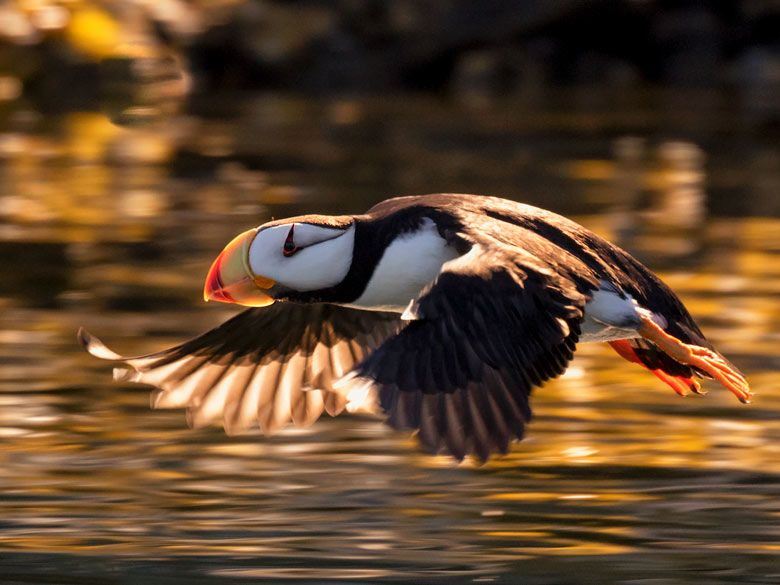
1. Get ready for FAST!
Puffins can fly up to 40 miles per hour, beating their wings 5 to 7 times a second. And beat their wings they must. No soaring for these birds. Like bumblebees, if they stop flapping their wings, they drop like a rock.
To successfully capture a puffin in flight, you must treat it as a sporting event. Indeed, that’s how I learned to shoot puffins (with my camera), from a professional sports photographer.
“It’s no different than shooting a football game or a tennis match,” he said, pulling out a 500mm lens. “You need to anticipate the action or you’ll miss it every time.”
In the photo below, (which I call “Run, Puffin, Run!”), my shutter speed was 1/500 of a second. See how the wings are starting to blur? The shutter speed is borderline too slow. Try to keep your shutter speed at 1/1000 of a second or faster. Otherwise, the dark wings will blur and disappear, which almost happened here.
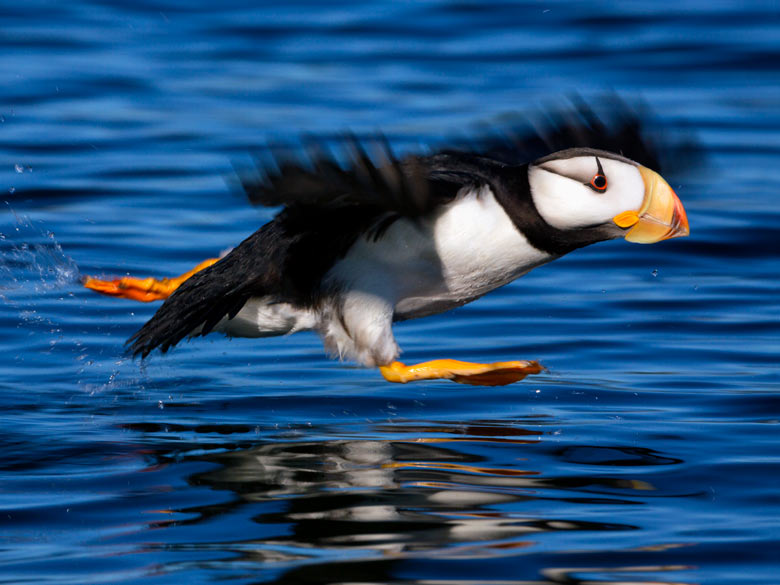
My camera settings: I set my camera on aperture priority and adjust my ISO so that I’m shooting at least 1/1000 of a second.
My favorite lenses: Because I often shoot from a boat or inflatable skiff, I have to be ready for ever-changing conditions. So I normally use a 100-400mm, 200-400mm, or a 70-300mm lens. Prime lenses such as a 300mm, 500mm or 600mm are also wonderful for bird photography, but I prefer the flexibility of zoom lenses.
My thoughts about smartphones: Most people who come out on our boat bring a smartphone. To be honest, use them to take stills of puffins, but I don’t think you’ll be satisfied. Use your smartphone to shoot movies.
[perfectpullquote align=”full” bordertop=”false” cite=”” link=”” color=”” class=”” size=””]Click here to sign up for my newsletter: Monthly missives on photography, organic gardening, life, and recipes outside the cookbook.[/perfectpullquote]
2. Consider the background
When photographing puffins, or any bird on the water, take into account your background. To create water that is richer and more complementary (rather than a bald, silver-gray color) try placing the bird between you and the shore. Or in such a way that the water will take on the reflections of the shore, be it a grassy knoll, boats in the harbor, or trees.
The dark green water in the photo below is created by the spruce trees’ reflection of the water. Rich and lovely.
3. Adjust your exposure settings
That said, a dark background will cause your camera’s light meter to overexpose. This means the whites on the puffins’ head (and body, in the case of the horned puffin in the photo) to be overexposed or blown out, with no texture.
When photographing a white object against a dark background, I often underexpose (decrease my overall exposure) between one and two stops.
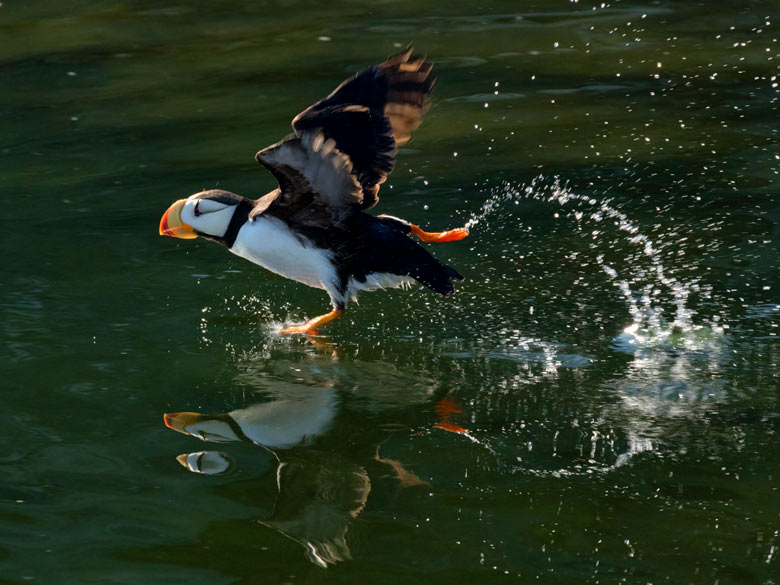
Yes, I learned how to photograph puffins not from a bird expert, but from a sports photographer. He was a guest in our bed and breakfast, arriving in Kodiak with a full arsenal of camera gear.
One day, while out on our boat photographing sea otters and puffins, he shared more photo-wisdom. “Study your subject. Look for patterns,” he said. “That way you’ll know what to expect. You’ll be ready.”
So let’s discover some cool things about puffins…
8 fun facts about puffins
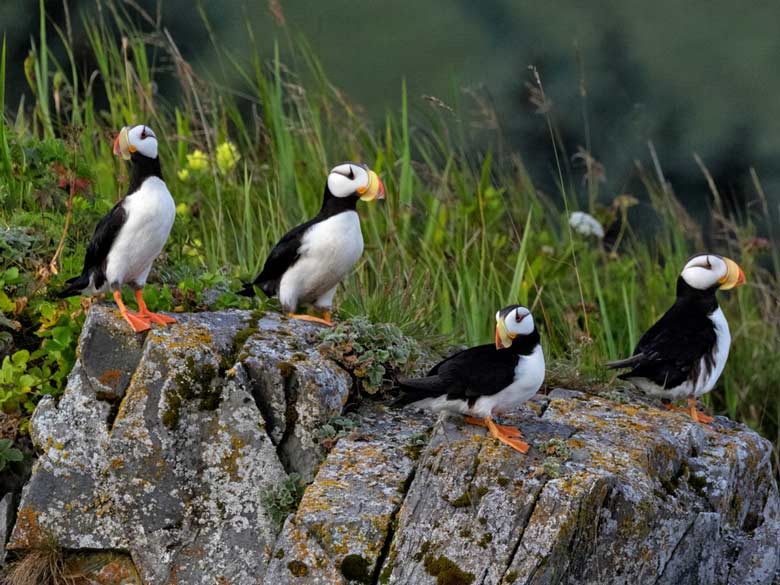
1. How long can puffins hold their breath?
Like diving birds, puffins “fly” underwater. They can dive to 200 feet and stay underwater for up to two minutes. Their movements are ballet-like, flapping their wings to drive them along and using their rudder-like feet like to steer. If you find yourself in Seward, Alaska, be sure to visit the Alaska SeaLife Center to watch puffins ‘perform’ underwater.
2. Puffin beaks change color
A puffin’s beak is large and technicolored. But it’s not colorful year-round. In late August, the reds and yellows begin to fade, the outer sheath begins to crack and ‘unzip’ from the beak.
Just before winter the birds shed the outer layer of their bills, leaving them stubbier and duller. When spring arrives, though, their beaks return to their bright form, just in time for mating season.
It’s all about the dating game.
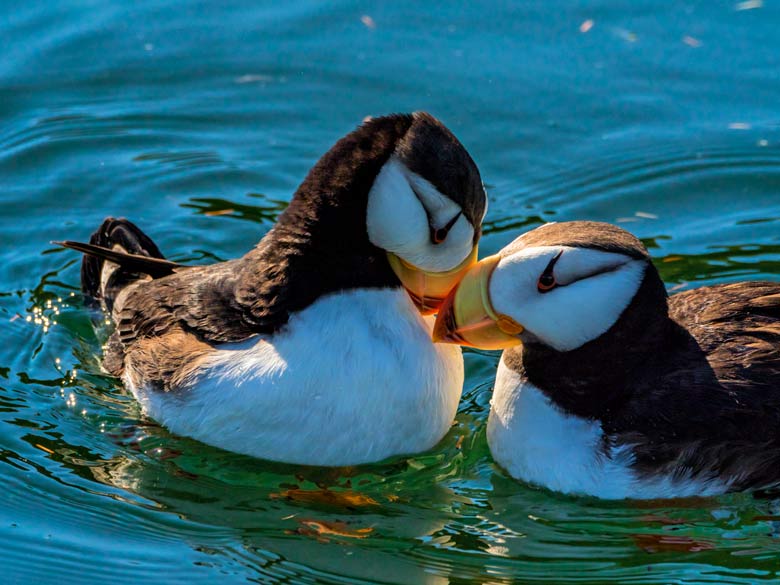
3. Are puffins related to penguins?
Nope, not even distant cousins. Puffins resemble the black and white Antarctic birds, but they are definitely not flightless. There are four kinds of puffins in the world (from largest to smallest): Tufted, horned, Atlantic, and the rhinoceros auklet. Around Kodiak Island (in the North Pacific) we are blessed with three out of four species. And it’s not the Atlantic puffin.
Here’s a chart showing the four species of puffins (courtesy of puffinpalooza.com)

4. It ain’t easy (for a puffin to fly)
Puffins might be fast flyers, but it’s tough getting to that point.
When puffins take off from the water, it’s after a long struggle to get airborne. I can’t help but see similarities between puffins and Fred Flintstone, who would rev his car by plodding along the ground with his feet.

When attempting flight, puffins bounce again and again across the surface of the water, until some unknown law of physics permits them to become free from the water’s pull and thus airborne.
5. Do puffins migrate like other birds?
Atlantic puffins get most of the attention. They’re easy to study. On the Pacific side though, puffins are shy and reclusive. So little is known about a puffin’s life. What we do know is that in April, puffins return from the open ocean, having spent the winter in conditions that would make Captain William Bligh seasick.


6. Where do puffins nest?
Puffins return to the same nest each year. Rather than build nests, mated pairs prepare holes in the rocks or dig holes in the sod on top of a cliff or overhang.
Egg-laying season is between mid-June and early July. The adults take turns incubating the single egg for about 40 days.
Once it hatches, the parents again take turns caring for, and feeding the chick. This increase in activity, when mom and dad do their best to keep junior happily fed, makes for some of the best puffin viewing (mid-July to late August).
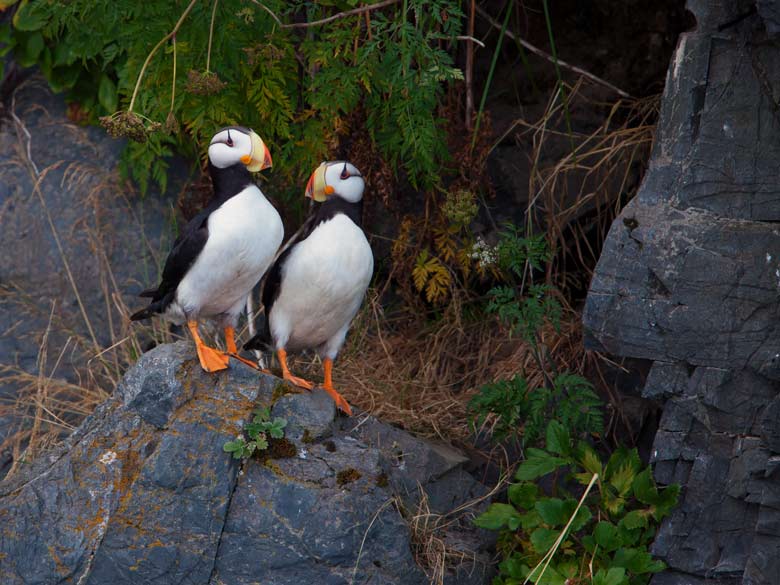
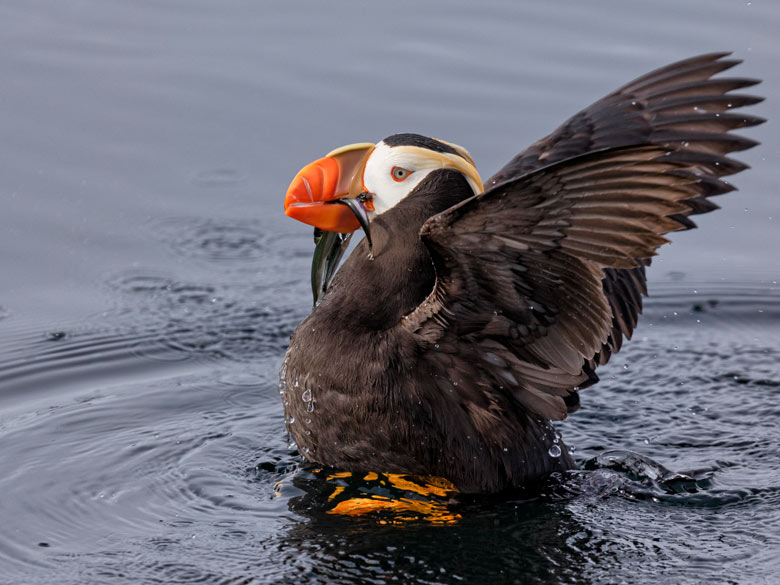
7. What do you call a baby puffin?
A puffling. True story.
Then around September 7, the parents leave the nest for good, under the cover of darkness. Where do they go? They head back to sea. In the process, they abandon the chick that they’ve nurtured all summer.
No more free lunch for the check. What drives the chick to leave its comfy home and head to the open ocean? Hunger.
After describing this strange, end-of-summer turn of events, a friend of mine sighed and said, “Perhaps the same tactic would encourage my teenagers to get on with life.” Adding, “Just lock the fridge and the cupboards!”
[perfectpullquote align=”full” bordertop=”false” cite=”” link=”” color=”” class=”” size=””]Perhaps one day, all these conflicts will end, and it won’t be because of great statesmen or churches or organizations like this one. It’ll be because people have changed. They’ll be like you, Puffin. — Kazuo Ishiguro[/perfectpullquote]
Take a look at this is a cute movie about puffin love (2:16 minutes)
8. How long do puffins live?
As far as birds go, puffins lead long lives—often more than two decades. The oldest known puffin lived to be 36.
Finally…
How do I love puffins, let me count the ways…
Enough to dedicate the first of May as “Celebrate the Return of Puffins to Kodiak Day” on my annual wall calendar. To see or purchase my latest calendar, click on this link.
Here’s an image of a tufted puffin that I used in a recent calendar for the month of December. The sparkles added a holiday feeling…

Finally, on that special day in the kayak, when the puffin flew by, the encounter lasted only a few seconds. But it embedded a lifetime of appreciation for these amazing sea parrots.
I hope you enjoyed this article and found helpful tips. If you have any questions, drop me a line or better yet, leave a comment below.
With cheers, gratitude, and blessings,

P.S. Sign up for my monthly newsletter and get your free copy of my 4-page booklet of photography tips. You’ll feel recharged and inspired when taking pictures.
HI Marion. I am traveling to Alaska this summer and will be there at the beginning of July. I am mostly a bird photographer and live in Florida. I spend most of my year chasing great egrets, blue herons, and reddish egrets around. I would like to know where I can have the most success photographing puffins in their natural habitat. I will only have a day to two to myself to do so as I am traveling with my family and they will only spare me for that long, lol. Where can I get the biggest “bang for my buck” so to speak and get some up close and intimate photos of these beauties? Looking forward to your reply. Can you please email me at the address below? Thanks so much!!!
Liz FB at Elizabeth Holmes
Thanks Marion. Great fun and inspiration. Now I’m encouraged to grab my binos & head out to Abercrombie.
Marion, awesome photos, wonderful writing and altogether a heartwarming piece of art. Thank you!
A warm and fuzzy thanks, back at you, Natasha! Have you been able to get out to photograph birds lately? You have such wonderful opportunities nearby.
Hi Kathleen… glad you like the puffin photos. For the calendar, I can mail you one. $15 + shipping which is about $4. I’ll be announcing more on Facebook.
Love your Puffins and want the calendar. 🙂
Fantastic puffin photos! One of my two favorite puffin stories involves a potential customer of one of the charter flight operators working out of the downtown spit many years ago. The gentleman entered clutching the air charters flightseeing brochure. “How much will it cost to go see one of these?” he asked as he pointed to the colorful, full-bodied photo of a puffin on the cover.
“$300” responded the pilot, eager to hook a sale. “For only $300 I can go see one of these?” asked the visitor. “That’s right!,” guaranteed the pilot proudly. “Fantastic price!,” said the man. “You see, son, this is a picture of an Atlantic puffin! We’ll have to fly to New Foundland to see this bird!” The pilot had requested a file photo of a puffin from the state’s tourism office who had apparently acquired a “puffin” pix for its wildlife photo file. No bird watchers in Juneau I guess!
Ha, Tom, made me laugh. Pam was just here for dinner: All local — turkey, roasted veggies, berry cobbler. Nice. Cheers!
Marion,
As always — your photo’s make one stop to ponder the marvels of nature.
Thank you for these moments.
Robin
Thanks, Robin. As always, good to hear from you. Cheers and blessings to you.
Marion, Great puffin pictures!! How do I get one of your calendars?
Ileen
Ileen, do you still have my email address? I will be mailing out calendar orders ($15 each) as soon as they arrive; around October 18. Does that work?
Thank you for this Marion. Like you I am a puffin enthusiast. Being in Scotland I only know the Atlantic puffins. I first met them when I used to rock climb on sea cliffs many years ago and since then have sought them out in many different places in the north of Scotland, mainland and islands. Your photos are brilliant. Jean x
Hi Jean, Thanks for your comments. I’ve heard that Atlantic puffins are quite the characters; in some places are totally unfazed by humans. Either way, puffins are so captivating to observe. Do the Atlantic puffins leave for the winter?
They have already gone off to sea for the winter. We only see them when they are on land to breed. The Atlantic puffins are in crisis, around here at least, because they feed the pufflings in the burrow almost exclusively on sand eels and climate change seems to be making them more scarce every year. Sand eels are bottom of the food chain for many sea birds in northern Europe and there has been a general decline in many populations. A real worry, we hope some new protected areas of sea and seabed will at least limit the destructive effects of over fishing and dredging. Are the Alaskan puffins thriving?
I’ve heard that some of the Atlantic puffin colonies are hurting; this last year was very good for the puffins because there was a lot of feed close in to the burrows. Not all years are that good, though. Fortunately, there is a variety of food for them.